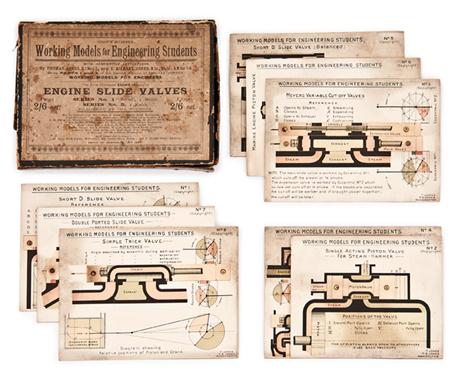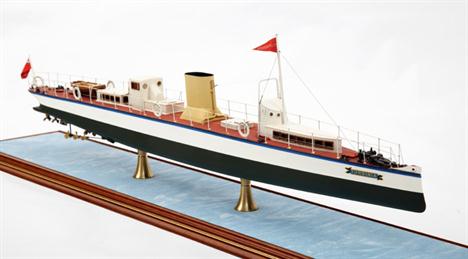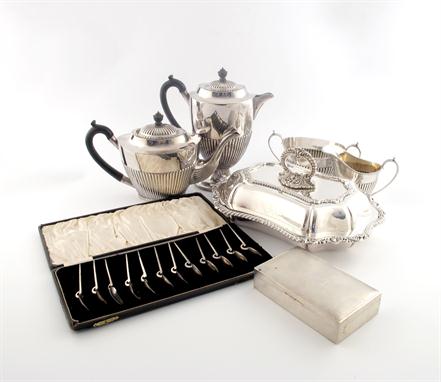A gold card case by Boucheron, rectangular form with engine turned geometric design to both sides, thumbpiece set with calibre cut sapphires and engraved with cipher to the interior. Signed Boucheron Paris with French control marks. 6.5cm wide. 56g. In fitted Boucheron box with Paris, New York and London addresses.
186062 Preisdatenbank Los(e) gefunden, die Ihrer Suche entsprechen
186062 Lose gefunden, die zu Ihrer Suche passen. Abonnieren Sie die Preisdatenbank, um sofortigen Zugriff auf alle Dienstleistungen der Preisdatenbank zu haben.
Preisdatenbank abonnieren- Liste
- Galerie
-
186062 Los(e)/Seite
A rectangular silver and gold compact by Boucheron, the engraved and pierced cut card cover depicting birds and five cabochon sapphires set to flowers. Hinged mirror and cover to the powder section. Engine turned pattern overall. Signed Boucheron London and numbered 575012 with assorted French control marks and UK import marks. Leather case.
A French gold rectangular snuff box with engine turned decoration and scroll chased borders. Inscription to the interior `G Grisi Mario A JL Hutton, Liverpool 12th Ottobre 1853` 8cm. 73g. With maker`s lozenge and French control marks. With written note explaining that the box was presented to JL Hutton the composer. And a pique decorated tortoiseshell card case.
A Silver Georgian Keywind Brast Fusee Pair Cased Pocket Watch London 1799, decoratively engraved movement with maker`s name French and March 1800, engraved on movement and movement case, the white enamel dial with roman numerals, the outer case has an engine turned design London 1827. Measuring diameter of 55 mm.
A FINE AND WELL-PRESENTED 1:48 SCALE STATIC DISPLAY MODEL OF THE WORLD’S FIRST TURBINE-POWERED CRAFT TURBINIA DESIGNED BY SIR CHARLES PARSONS IN 1894, modelled by John R. Haynes with bespoke pre-formed hull, painted deck with superstructure and fittings as appropriate and including anchor, winch, glazed wheel house with steering wires to aft rudder shoe, deck rails with named life buoys, raked buff-coloured funnel, engine room companionway and observation post, fitted dinghy with gratings, oars etc, the two-tone hull fitted with three propeller shafts each supported three brass propellers, mounted on brass columns within wooden glazed case with maker’s plate. Cased measurements -- 9¾ x 31 x 6in. (25 x 79 x 15cm.) Turbinia was designed by Sir Charles Parsons, inventor and builder of Parsons turbines. She was built by him in 1894 to test Parsons turbines in service and to demonstrate the advantages of turbine vs reciprocating engine propulsion. Naturally, the fastest type of craft should be used for such demonstrations. It was a sad blow when, powered by one radial flow turbine, Turbinia made less than 20 knots due to cavitation at the high turbine speeds of 1800-2000 RPM. Parsons made many studies of cavitation. The single turbine was removed and replaced by three Parsons parallel-flow turbines, each driving a shaft with three propellers on each shaft as clearly seen in this model., The Royal Naval Review for Queen Victoria’s Jubilee took place at the Spithead in 1897. With all the ships of the Navy, guest vessels, and huge crowds looking on, the tiny (comparatively) Turbinia ripped through the rows of cumbersome naval vessels at an astonishing 35 knots. This bravado display effectively demonstrated beyond question the superiority of steam turbines, and in a very short time successful turbine installations had been made and put in service on coastal steamers. The Cunard Line experimented with turbines in the 20,000 ton Carmania, and then entrusted turbines to their Mauretania and Lusitania. Both ships became world famous, the former holding the transatlantic speed record from 1910 to 1929., Turbinia was solely a demonstration vessel to show, as she certainly did, the advantages of turbine drive. Her weight of 44½ tons divided by her horsepower gave a very low 49 pounds per horsepower, only to be surpassed five years later by the American Arrow which, even with reciprocating engines, achieved a figure of 36 pounds per horsepower., Shortly after being photographed alongside the Mauretania, the first large, fast, turbine powered ocean liner, she was laid up on the Tyne. Her after part was retired to exhibition in 1927 in the Imperial Science Museum in London. In 1961 both halves were re-joined in Newcastle on Tyne where she can now be seen.
A BUILDER’S MODEL OF THE TUG IRANDE, BUILT FOR THE THAMES STEAM TUG & LIGHTERAGE CO. LTD. BY JOHN I. THORNEYCROFT & CO. LTD, SOUTHAMPTON, 1929-30, the carved hull fully painted with gold-plated fittings including anchor davit and winch, foremast with navigation lamps, air intake, bell, wheel house with helm, telegraphs, klaxon, life buoys, counter-weighted collapsible funnel with company colours, ventilators, navigation lamps on brackets, engine room hatch covers, tow hook etc, mounted on turned wooden fittings within glazed wooden case and ivorine builder’s plate (detached). Cased measurements -- 14 x 29½ x 13½in. (35.5 x 75 x 34.5cm.), No ‘Irande’ is listed in the company inventory compiled by K.C. Barnaby in his history of Thorneycroft, however, two motor tugs numbered 1084-5 were built in 1929-30 for the Thames Steam Tug & Lighterage Co. The single name listed is Wortha which has the same overall length noted on the model’s plate, the next deliveries to this company were for diesel electric tugs in 1935 and 1937. What Wortha’s sister was called, or their fates, remains unknown.
A FINE BUILDER’S MODEL FOR A THREE-MASTED SCHOONER-RIGGED STEAM YACHT, PROBABLY BARROW SHIPBUILDING CO. LTD. C.1873, the hull carved in laminated fruitwoods with ebonised topsides, brass glazed portholes, finely carved figurehead, lined and planked decks with lined and painted superstructure, brass and silvered fittings including four boats in davits, open bridge with telegraph, binnacle and helm, raked stayed funnel, engine room lights, gratings, saloon, benches etc., three raked two-stage masts with standing and running rigging, mounted on brass columns within wooden display case with access door to stern. Cased measurements -- 24 x 37 x 14in. (61 x 94 x 35.5cm.), Provenance: Langfords Marine Antiques., Although un-named, this model bears a striking resemblance to one sold by Messrs Christie’s, South Kensington in sale 9855 (24 May 2004, lot 324) and which was known to be the S.Y. Aries built for Sir James Ramsden in 1873. That model also bore no name, but her unique propeller arrangement and lines gave ample means of confirming the identity suggested by a later plaque. It seems reasonable to suggest therefore that this model is not a proposal model but another yacht of similar vintage whose identity has yet to be revealed.
lepaute a Paris, a French Siena marble clock garniture the eight-day duration movement striking the hours and half-hours on a bell with an outside countwheel, the backplate signed in script with the roulant blanc makers’ name, ‘Pons’, the gilded dial with engine-turned decoration to the centre, black Roman numerals, blued steel moon hands and signed ‘Lepaute a Paris’, the rectangular case of Siena marble, with bronze acanthus leaf mouldings to the base, a bronze bezel and surmounted with a bronze urn, with a pair of matching side pieces, height 45 cm (clock), 28cm (side pieces). * The Lepaute family of well-known clockmakers are recorded as working from the mid-1700’s with Jean-Andre and Jean-Babtiste Lepaute working together before taking on the latter’s nephews, Pierre-Henry and Pierre-Basile before his retirement in 1789. Pierre-Basile’s son joined the business at a later date. * Honore Pons (Pons-de-Paul) was born in circa 1780 and is believed to have been apprenticed to the Lepaute workshop. He moved to St Nicolas-d’Aliermont in circa 1806 where he helped revise the French clock movement industry with the introduction of more mass-production and advanced tooling.
A silver-gilt dressing table set, by The Goldsmiths and Silversmiths Company, London 1918, engine-turned decoration, Greek key border, comprising: a carriage clock, a pair of silver-gilt mounted glass scent bottles and a glass toilet jar,a dressing table tray, a pair of pin trays, a rectangular box, three circular jars, a hand mirror, a pair of brushes, a pair of clothes brushes, a pair of glove stretchers, a comb, a shoe horn, a button hook and a five-piece manicure set, height of clock 9cm, approx. weighable 40oz. (qty)
-
186062 Los(e)/Seite























































